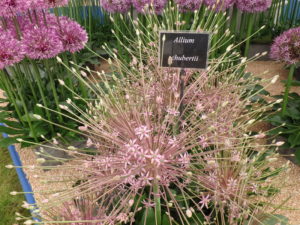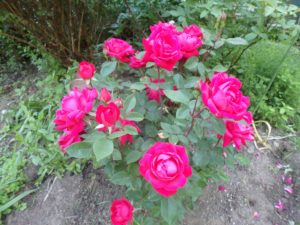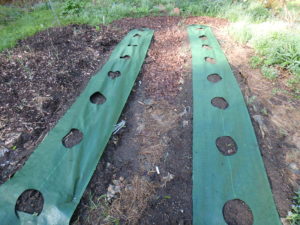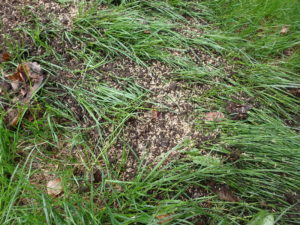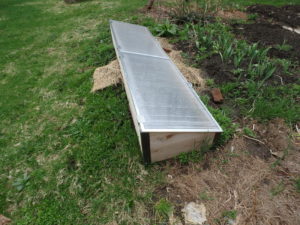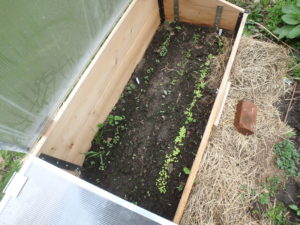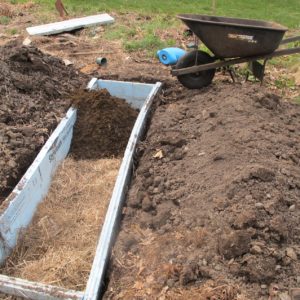The Chelsea Flower Show
It would be a bit of an exaggeration to say that I have always wanted to attend the Chelsea Flower Show in London. But not much. For years I’ve dreamed of going – and finally, this year, I went. Air ticket prices are down dramatically, the dollar is strong, and I decided there was no better time than now to cross off yet another item on my bucket list. It was well worth the effort.
Some basics: the Chelsea Flower Show is held on the grounds of the Chelsea Hospital in central London, which is now a retirement home for World War II soldiers. The show is bigger than anything in America: it encompasses 11 acres of displays, the vast majority of which are outdoors. That means that full-sized mature trees are installed, and in one case, a garden in a faux stone quarry was installed with blocks of stone stacked up more than 25 feet.
The show includes garden displays, rare plants, sculpture, food courts, vendors selling garden paraphernalia, music and much, much more. It has been an annual event since 1913 with the exception of a few years during the World Wars .
Tickets for next year’s show go on sale August 1, and although prices are not yet posted, tickets are not cheap – this year a full day ticket went for 100 pounds (($128). Each year the number of tickets is limited and they generally sell out before the event – this year some determined attendees apparently paid scalpers 500 pounds and more. It’s the Super Bowl of gardening.
If you want to go next year, the best plan is buy a membership to the Royal Horticultural Society, which allows you to attend a day before the doors open to the public, and offers discounted tickets.
I go to flower shows to learn. I delighted in seeing new (to me) species of flowers and new ways of combining flowers in the garden. I loved meeting garden experts and artists who created sculpture for the gardens.
So what are some of the things I learned? Thistles, which we generally consider weeds, can look great when planted in the garden. There I was in a city of millions, and a thistle, Cirsium rivulare ‘Atropurpureum’, was loaded with bees of all sorts! Clearly a great pollinator. Although a quick internet search did not lead me to seeds for that magenta-purple variety I saw there, I did find some seeds for a species native to the U.S. – Cirsium discolor – that is not the weedy pest farmers hate. So I shall order some seeds and try growing it.
Alliums were in all their glory at the show. Big, dramatic balls of flowers on 18- to 30-inch stems were used in many of the gardens. These are bulb plants in the onion family, and I have a few. I shall look for Allium schubertii which has an other-worldly pinkish flower head about 16 inches across. Another good one was just labeled with its variety name, ‘Powder Puff’.
Angelica (Angelica gigas) is another flower that was often used in the show. This is a 3- to 5-foot tall purple-leafed flower that I grew 25 years ago, but it is a biennial that does not come back after flowering, and I dropped it from my plant palette. But I have already purchased and planted one since returning from the Chelsea show. It can be very dramatic in the garden.
Ferns were used as filler in many of the gardens at Chelsea, and I shall try using them, too. Of course, their gardens only had to look good for 6 days, so ferns that spread, or get too tall, were not a problem, though they might be in my garden. I have a patch of Japanese Painted Fern (Athyrium niponicum) which is great in dry shade. But this summer I will investigate other ferns. Many nurseries sell them, but I admit I haven’t paid much attention to them.
Interesting people I met? George Ball, owner of Burpee Seeds was there. He is a highly knowledgeable (and opinionated) plantsman who is passionate about seeds. I was interested to learn from him that Melania Trump’s grandfather was a Slovenian onion breeder.
Mr. Ball pointed out that most vegetable seeds originally came from Europe, which is actually farther north than we are – and hence not good choices here. He believes that modern hybrids, not heirloom seeds originally from Europe, are best. And he told me that in a blind taste test, 4 of 5 times, Burpee’s hybrid ‘Brandy Boy’ beat the heirloom ‘Brandywine’, which is one of my favorites for flavor. I am trying it this year, since it ripens earlier, and produces more fruit, according to him. I’ll let you know how mine do in August.
At a reception on press day by David Austin Roses for a new rose named after actress Dame Judi Dench, who was there, I met the 91-year old founder of the company. I was able to thank him for all the beauty he has introduced to the world.
The English know how to throw a party – or have a flower show. Picnics with champagne were everywhere. Women were dressed in flowered clothes and elegant garden hats; men wore suits, even in the hot sun. Of course, everyone was very polite. And I got to check off another item on my bucket list.
Read Henry’s twice-weekly garden blog at https://dailyuv.com/
Tips for Growing Better Roses This Summer
My grandmother and mom grew roses, even though their roses were often plagued by bugs and diseases. But in recent years the rose industry has produced a number of carefree roses that anyone with 6 hours of sunshine and even a slightly green thumb can grow.
Probably the first place to start a quest for a great rose would be at a good family-run garden center. Find the rose expert there, and ask about good varieties for your area. In general, fragrant roses tend to attract Japanese beetles and other insect pests. I personally like the ‘Knock Out” rose series. These roses are highly disease resistant and, in my experience, they attract few pest bugs. There are other disease-resistant varieties, of course.
If you live in a cold place where winters reach minus 25 or more, I’d look at the Canadian Explorer series of roses. These were developed in Ottawa, Canada and include those tough rugosa roses in their gene pool. Rugosa roses are also called beach roses, since they often grow in pure sand on the dunes of Cape Cod and elsewhere.
A good resource for selecting and maintaining problem-free roses is a book I like very much, Roses for New England: A Guide to Sustainable Rose Gardening by Mike and Angelina Chute. This book is full of information relevant to New England gardeners, and reading it would be a good way to educate yourself about roses. It reinforces what I have learned about roses over the years – and taught me some things I didn’t know.
So what do roses want? Good soil with a slightly acidic pH, plenty of sunshine, soil that is slightly moist all the time, a little fertilizer, and someone who loves them and is willing to pull off the beetles and drown them.
The soil that roses want is a good loam amended with compost. Dig a hole that is about two and a half feet wide and 18 inches deep. Keep half the soil and mix it with an equal amount of compost in a wheelbarrow or on a tarp.
You could send away a soil sample to determine the soil pH and to see what minerals are deficient, though that might take a few weeks before you get a response. Or you could just go to your local garden center and buy a kit for testing soil pH. Much of New England has acidic soil, but roses like something in the range of 6.0 to 6.8 – slightly acidic.
You can improve your soil pH by mixing in limestone (which is available in bags at your garden center). Mixing in a cup per rose is a good start, depending on your soil pH. I knew a rosarian who always buried a 4 inch square scrap of Sheetrock (wallboard) beneath each rose to provide calcium and improve soil pH over time. A cup of bone meal or rock phosphate at planting time will add phosphate, a mineral that roses need.
Roses need sunshine to do well, the more the better. The Chute’s book taught me that if you have to choose morning sun or afternoon sun, go for morning sun. That way the dew dries up more quickly – and fungal diseases, which love wet leaves, are minimized naturally. Six hours of sun is considered adequate, but the Chutes mention that roses with fewer petals need less sun to bloom.
I have a rose right near my front door – and the hose that is connected there. It has bloomed well for decades, in part, because every time I fill a bucket, wash the car or use the hose, I give the rose a nice drink. Roses love water. I have a watering wand on the hose so that I can direct water to its base, and not wet the leaves. In dry summers watering roses is key. How much? At least 5 gallons per week for a mature rose.
I rarely fertilize my roses, but the Chute’s book says that fertilizing regularly increases blooming. I might try a couple of applications of an organic liquid fish fertilizer this summer. Be aware that too much fertilizer pushes fast growth that is more susceptible to diseases and insect damage.
What else should you consider when selecting roses? I like roses grown on their own roots, not grafted onto root stock. If the plant dies down to the soil over winter, a rose will sometimes send up shoots from the roots, which are different from the rose you planted if you buy grafted roses.
Also read the tag carefully to see if it is a one-time bloomer each season, or a re-bloomer. Some roses like the Knock-Out roses bloom for most of the summer. Be sure to cut off blossoms after flowering to encourage more blossoms.
Finally, now is the season to cut off any brown, dead portions on stems – most roses suffer a little winter damage. Cut above an emerging leaf.
I’m an organic gardener which means I don’t spray my roses, not for fungal diseases, not for insect pests. I firmly believe that if you have a rose in good soil with good sunshine and adequate water, your roses will be healthy and not attract many insects.
Henry is at the Chelsea Flower Show in London this week, and will not be answering questions. Read his report on the show next week!
It’s (Almost) Time to Plant Tomatoes
Maybe you’ve already planted your tomatoes. I have not. I’m waiting until June 10. By then, even in my cold Zone 4 garden, I know there will be no more frost and the ground will be above 60 degrees. And the stars, moon and planets will be aligned from June 10 to 12 to promote success for fruits, one of the 4 categories listed in the Stella Natura calendar, a biodynamic guide that I follow (www.stellanatura.com).
I start my seedlings indoors in April, and I’m in no rush to put my babies outside in the cold, rainy world that I’ve been seeing in May. And even if you have planted yours, I bet mine will catch up with yours. Tomatoes hate cold feet and a few days of chilly rain will make them cranky – and slow their growth.
Before my tomatoes and other plants get in the garden they get “hardened off.” If you are new to gardening, that just means I introduce them to the sun and wind over a period of time. An hour at first, or a morning on a north-facing deck. Later 4 hours of afternoon sun, and finally, if the temperature will stay up above 50 all night, they have a sleep over outside, but out of the wind. All this just means when they go in the ground, they will not be shocked.
Do you buy your seedlings? Ask at the garden center if the plants you buy have been hardened off. Even Brussels sprouts can be damaged if they have never been hardened off and go right in the garden.
I want my tomatoes to have lots of vigorous roots. To help ensure this I pinch off most leaves on the stem, leaving just those on the very top – sort of like a cartoon palm tree. Then I bury that stem and it develops lots of extra roots. Sometimes I just plant the root ball and stem down deep. Other times I plant the tomatoes sideways: I make a space for the root ball, and a little trench for the stem. I cover all that, and turn up the stem at the top so the few remaining leaves are barely above the soil line.
Leggy broccoli can be planted deeply, too, to help it stay erect, and to develop more roots. Legginess is common for seedlings started indoors that have been a little light-starved, and I think all can be planted deeply, but only have done this with tomatoes and broccoli.
What else gets extra care and a late planting date? Eggplants, peppers, cucumbers, squash of all types and basil. They all like hot climates, and come from them. I did plant seeds in May including peas, spinach, carrots, beets, parsnips, cabbage and lettuce. Those are all doing fine. Actually peas went in a bit late and are not up yet for me at the time of writing.
Peas can be very slow to germinate, and can even rot in the ground if we get a lot of cold rain. I plant most everything in raised beds, in part, to get the soil to warm up early and to dry out better. My garden is near a stream and we have a high water table, so raised beds help. I just mound up the soil from walkways and add compost to get nice raised beds.
Peas and beans of all types can benefit by being inoculated with a bacterium powder that is sold in garden centers and at my feed–n-grain store. Peas and beans are legumes, a group of vegetables with nodules in their roots. If these contain rhizobium bacteria, they take nitrogen from the air and “fix” it so that it stays in a form useable by plants. Free fertilizer, if you will.
Contrary to “rural legend”, the nitrogen fixed by peas and beans does not improve the soil very much. I always thought the rhizobium bacteria were pumping nitrogen into the soil. In fact, most of the production is used by the plants themselves.
The nodules that contain the bacteria are generally pink or reddish when producing well, and can be as big as a pea. When you pull a pea or bean plant, look at the roots. If you do not see lumps of nodules, be sure to introduce the bacteria next year (it may or may not be present in your soil naturally).
A few words about mulching: do not mulch your plants right away. Wait until the soil is very warm – 60 degrees or more – before mulching. Yes, the mulch will keep down weeds and hold in moisture, but it will also prevent the sun from warming the root zone.
I know gardeners that like to put down black plastic to kill weeds and add heat to the soil. I have used it –particularly for growing watermelons and pumpkins – but don’t like it. Most plastic lasts just one year and then has to go to the landfill. It’s not a sustainable practice.
I do like using woven landscape fabric, however. A Vermont company, GardenMats, produces rolls of fabric with pre-cut holes spaced for specific crops. These mats keep down weeds but let air and water pass through. The rolls are 4 feet wide, but I slice mine down the middle as my raised beds are only about 30 inches wide. I put leaves or mulch hay around the edges and in my walkways.
New England weather is never predictable, so I tend to plant later than many gardeners. Usually I am glad I did.
Read Henry’s blog at dailyUV.com.
Spring Lawn Care
Lawns? My philosophy is this: If it’s green and you can mow it, it’s a lawn. Dandelions? Who cares? Their blossoms are cheerful. Creeping Charlie, plantain? Pests, but not awful. And so on. I love a lawn with some biodiversity. But bare and thin spots I like to fill in or over-seed. Now is the time to do that.
I recently called Paul Sachs of North Country Organics, manufacturer of Pro-Gro fertilizer and more, to talk about spring lawn care using organic products. Paul explained to me that all the New England states have laws against applying phosphate-containing fertilizer on lawns. Why? To minimize phosphate run-off into lakes, ponds and streams, thus reducing the growth of algae and other plants from running rampant and diminishing water quality.
Mr. Sachs explained that this law makes it technically illegal to fertilize your lawn – unless the middle number on your bag of fertilizer is “0”. Farmers who spread manure on the fields are exempt from this provision, and their fields are much more likely than you to cause run-off of phosphates.
There is a loop-hole to the law, however. Paul Sachs explained that you are allowed to fertilize with phosphate-containing fertilizers if you are also spreading seed. Most lawns have some thin spots, or bare spots, so adding seed makes sense. And if you use an organic fertilizer like Pro-Gro (a 5-3-4 fertilizer) there is very little soluble phosphate anyway. Its phosphorus content comes from rock phosphate, bone meal and bone char – all of which are only minimally soluble, and not normally a problem.
What is involved in over-seeding? Basically, you need to spread 3 to 5 pounds of seed per 1,000 square feet of lawn (roughly 30 feet by 33 feet). First, cut the lawn a bit shorter than you would otherwise. Then rake the lawn to remove the cut grass and any dead material that is on the lawn. You want seed to be in contract with the soil. If you have the time and energy, you can scuff up the soil in bare spots with a garden rake before spreading the seed. You can spread seed with a mechanical seeder, or, for small spots, just fling it using your hands.
I buy a small truckload of compost each year for use on my gardens and lawns. It is loose and fluffy and is easy to distribute. After spreading some seed, I fling compost with a shovel over the seed, and then smooth it out using a lawn rake turned upside down. My goal is to spread a quarter to a half an inch of compost on the lawn, at least in the areas that look the worst.
Compost is not necessarily rich in nitrogen – the driver of green growth – but it has organic matter, beneficial microorganisms and micro-nutrients that would not be found in a chemical fertilizer. If you are really interested in a deep green lawn with lush growth, you could not only spread compost, but also some organic fertilizer – Mr. Sachs recommends about 20 pounds of Pro-Gro per 1,000 square feet of lawn.
Almost any store that sells seed will have something called “Conservation Mix”. That is what I use. A typical mix might have 35 percent creeping red fescue, 25 percent turf type tall fescue, 10 percent Kentucky bluegrass, 12 percent turf type perennial ryegrass, 15 percent annual ryegrass, 3 percent white clover.
A few words about clover. When I was a kid back in the 1950’s, we sometimes spent lazy afternoons rolling around on the lawn and looking for 4-leaf clovers, said to guarantee good luck. But since then chemical companies have perfected “Weed-n-Feed” products that provide herbicides along with fertilizers to “ensure a perfect lawn.” Those products kill clover. So what have they done? They have declared clover a weed.
Clover is not a weed. It is a beneficial plant that actually takes nitrogen from the atmosphere and fixes it in the soil, essentially giving you free fertilizer. The seeds are tiny, so a little in a mix goes a long way. If you get an organic fertilizer it has no herbicides, so of course. And when you buy a bag of conservation mix, you may want to turn it upside down and shake it a little. Clover seeds tend to migrate toward the bottom of the bag, potentially giving an uneven distribution.
A conservation mix has the advantage of biodiversity. If a pest or disease attacks one grass, another might not be affected. Kentucky blue grass, for example, is lush and gorgeous, but susceptible to many diseases. A little is better than a lot in a mix.
Unless your lawn is right on the edge of a stream or lake, you probably will not be causing any problems by fertilizing your lawn a little. Lawn is a great filter, and will generally prevent the migration of fertilizer into water bodies. And there are organic fertilizers that have no phosphates at all: North Country Organics has a 6-0-6 called Natural No-Phos.
I know that some gardeners remove their lawns and put plants everywhere. But before you do that, remember that lawn is the easiest of all plantings to maintain. A little work now, some mowing as needed, and it looks good. Especially if, like me, you are not worried too much about the presence of a few dandelions.
Read Henry’s twice-weekly blog at https://dailyuv.com/




